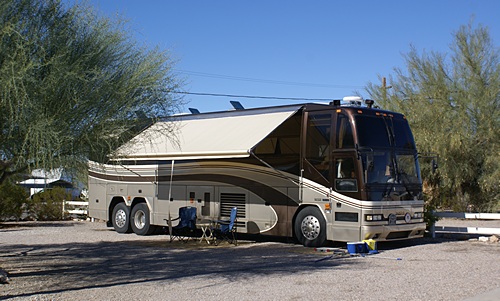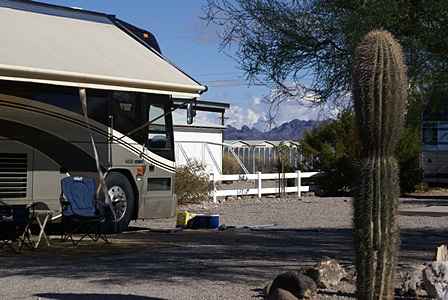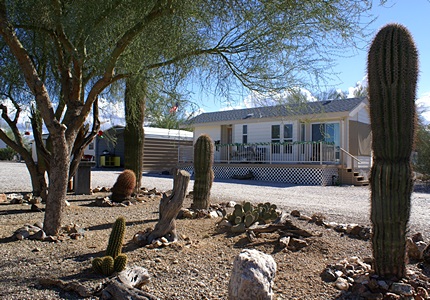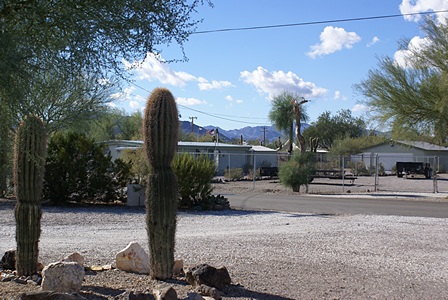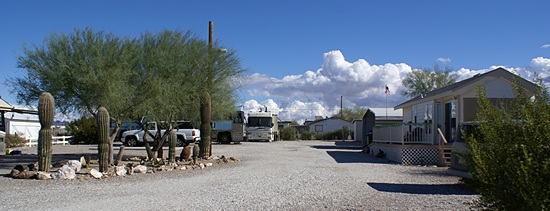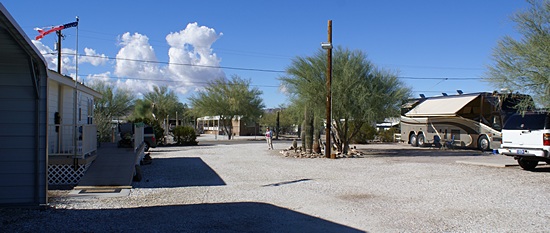2014/12/13 (S) Ahhhh
Linda was very tired last night and was asleep by 10 PM. Although I was up until almost midnight we were both wide awake by 5:30 AM, so I got up and made a full pot of coffee. We enjoyed our brew while watching the slow but inevitable progression of night to day. It was very quiet last night; the only sounds I was aware of were the noises the coach makes (refrigerator and auxiliary air-compressor). The rain last night was gentle and a somewhat rare event for this area at this time of year, so Linda got online with her iPad to check historical weather data and forecasts.
The average rainfall for Quartzsite in December is 0.07 inches, the maximum is 0.7 inches (10 times as much) and the minimum is zero. The average high is in the mid-60s and the average low is in the low-40s. On any given day the forecast is sunny with gentle winds and no fog or rain. January is slightly cooler on average and February warms back up a tad. You can see why people spend the winter months here. Sunrise was at 7:32 AM. We are ~20 miles from the California border, as far west as we can go without moving into the Pacific Time Zone, so sunrise and sunset are later here relative to the local time.
Linda made fresh blueberry vegan pancakes for breakfast with real maple syrup and they were excellent. After breakfast we got out the vacuum cleaner hose and attachments and vacuumed the coach. This terrified the cats, who have limited places to hide, but it had to be done. Linda then mopped the tile floor. She wanted to dust but I suggested the all the cleaning did not have to be done the first morning we were here. She bundled up the trash and took it to the large garbage can and stopped to chat with Fonda and Connie (our landlady) on the way.
By 8:30 the sun was climbing in the southeastern sky and the coach was warming up a bit. We are parked facing east so we decided to deploy the passenger side awnings (patio and bedroom) which shaded approximately 65% of the upper half of the south-facing side of the coach. Linda then decided we should wash the front of the coach.
I got the step stool and Little Giant ladder out of the front bay while Linda got the collapsible water bucket. We started with the front of the bus using water directly from the tap but it dried too quickly in the sun and left spots. We switched to softened water from our fresh water tank and took a team approach with me scrubbing using a Microfiber sponge and Linda following right behind drying with Microfiber cloths. That seemed to work better.
After we finished the front we moved to the rear. The sun had not yet pulled around to west of south so we did not have direct sunlight on the rear cap. We hooked up our longest hose to the other water softener outlet and then wet the surface, scrubbed the cap with our soft brush, and rinsed it off without using the Microfiber drying clothes. We will clean the two sides of the coach over the coming week, doing a little bit each day. We also deployed the awnings on the driver (north) side of bus just to unwind them and let them air out and dry. We then set out our patio mat and welcome mat and our two bag chairs, completing our cleaning work for the day.
Butch spent some time emptying out their Suburban so we could explore Quartzsite in one vehicle. We all had lunch and then headed off to explore our winter home town. Fonda wanted to locate a church where she could attend services on Sunday mornings so we found one that looked like it might suit her. We drove down Main Street and Kuehn Street checking out the vendors and ended up at Big Market on west Main Street where we bought some grocery items and postcards.
Back at the ranch we settled in for a while before dinner. I worked at my computer and started checking up on e-mail, which I had not done in several days. I had a few from Gary, the publisher of Bus Conversion Magazine, and replied to those. I also spent a little time in RVillage and updated our profile. Jim Liebherr (Joe’s brother) came around to collect the first month’s rent and clarified access to the laundry room.
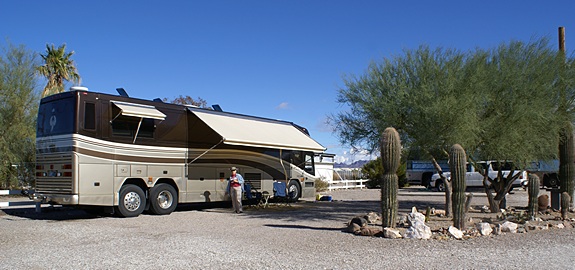
View of our motorcoach looking NE from Lollipop Ln. There are mountains in the distance to right of the rig.
For dinner Linda made a green salad using spinach, Mandarin oranges, and walnuts with a raspberry walnut vinaigrette dressing. She then prepared a zoodle dish using a tool called a “SpiraLife” that spiral slices vegetables with or without cross-cutting them. The cross-cut mode turns carrots, zucchini, etc. into long slender strips like flat pasta. She spiral sliced a zucchini and used it instead of wheat pasta in an olive oil sauté with mushrooms, onions, garlic, spinach, and sun-dried tomatoes. Some vegan “Parmesan” cheese on top, bread on the side, and a glass of Pinot Noir to wash it down made for a wonderful, healthy meal.
Linda found information online that suggested we should have anywhere from 11 to 21 over-the-air (OTA) TV channels. The Huffington Post even had the complete programming schedule for Quartzsite by channel and time-of-day. Our TV sets normally scan for standard OTA channels, both analog (very few left) and digital. We used both the front and rear TV to repeatedly scan for signals, pointing our amplified directional antennas around an entire 360 degrees, but did not find a single station.
The TV sets can also scan for QAM (Quadrature Amplitude Modulation) signals. We had to obtain an Access Code from the Westinghouse support website and enter it into the front TV to get it to scan for QAM signals, but it did not find any of those either. I called Butch to see if they had tried tuning in any stations. They had tried and got the same results as us. It’s not a big deal, the only TV we watch at home is streamed over the Internet, but it was puzzling as we saw lots of TV antennas around town. Most of them, however, where on top of tall poles.
The overnight low was forecast to be 41 degrees F and by 9 PM it had cooled off in the coach quite a bit. I decided to shut my computer for the evening and head to bed where we have a dual control electric heating pad to keep each of us in our own comfort zone. As sometimes happens, Microsoft decided that my computer needed to be updated. This often turns out be a recursive experience and tonight was no exception. Five updates were initially downloaded and installed, requiring a restart of the computer. After it rebooted and finished starting up I tried to shut it off again and there were six more updates, requiring another restart. I checked again after it rebooted and finished starting up and it appeared to be done, but I decided to leave it on overnight in case additional updates wanted to make their presence known.
I turned up the temperature on my side of the electric heating pad, got cozy under lots of covers, wrote for a while, and turned off the lights. It was a good first full day in Q.
2014/12/14 (N) Parker, AZ
The temperature in our motorcoach dropped below 60 early in the morning and the Aqua-Hot bedroom zone pump and heat exchanger fans came on even though we did not have a heat source turned on. That was because I had failed to turn the thermostat off before going to bed last night. With a 50 Amp shorepower connection I would have turned the three electric toe-kick heaters on, but with our 30 Amp connection I turned on the diesel burner and the electric heating element. Twenty minutes later the coach was warming up and I turned the electric element off so Linda could start cooking breakfast.
Linda made a tofu scramble using a different recipe that did not call for nutritional yeast as she forgot to pack any. We had sourdough toast with strawberry jam to go with the scramble, grapefruit juice, and coffee. Always coffee. After breakfast Linda went for a walk while I stayed at the bus. When she got back from her walk and Fonda got back from Church we discussed driving to the Wal-Mart in Parker, Arizona for groceries and sundry items. Butch left seating for four people in their Suburban so after lunch, he drove all of us to Parker.
What we saw of Parker looked like a nice little town. The Wal-Mart had a reasonable variety and quantity of fresh produce and we got most of the items on our shopping list. We noticed when pulling out that there was a Safeway supermarket across the street with a CVS Pharmacy next door. Parker is located on the Arizona side of the Colorado River and is the county seat for La Paz County which includes Quartzsite. It is also the location of the tribal headquarters for the Colorado River Indian Tribes, a consortium of tribes with reservations along both sides of the Colorado River for many miles north and south of Parker. The Bluewater Resort and Casino is one of the attractions in town.
Back at our winter home base we unloaded our groceries and then sat outside to read, write, and surf the web. It was cool in the shade and warm in sun. We chatted with Connie for a while and then retreated to our coach as the outside air temperature dropped. Linda had picked up a guide to the Lower Colorado River region while walking this morning so I settled in to read it. As it got dark Linda assembled our dinner. We had another nice salad, a bowl of the left-over curry, some bread, and finished the bottle of Pinot Noir. We read for a while after dinner and then went to bed.
2014/12/15 (M) Hard Water
The outside temperature dropped to 38 degrees F overnight, colder than at our house back in Michigan, but the high there won’t make it past 50, which is above average for this time of year, while the high here will be in the low 60s, which is normal. Add in the warmth of direct sunshine here and you typically have shirtsleeve weather.
I turned on the Aqua-Hot at 6:30 AM and went back to bed for half an hour while the coach warmed up. When I got up I put on the new sweatshirt and sweatpants that we bought yesterday and made a pot of coffee. We got the sweat clothing yesterday to wear in the coach while lounging around in the morning. I only brought a lightweight robe from home, and Linda only brought a lightweight nightshirt, both of which proved to be inadequate against the morning chill.
After breakfast we took showers and then called the Escapees RV Club to register for the Escapade rally and clarify the process for ordering clothing. I got transferred to Kim’s voice-mail and left my information. Rather than hang around the coach waiting for a return phone call we walked to “downtown” Quartzsite. Main Street is only 8/10ths of a mile straight south of our location and is only two miles long from Exit 19 to exit 17 of I-10. The city is basically four square miles (2×2)—with most of it north of I-10—and is flat terrain, so it’s a compact, easy place to get around on foot or bicycle.
Our first stop was the post office so Linda could mail a few postcards. There was quite a crowd there picking up and dropping off mail. From what we understand mail does not get delivered to street addresses here so everyone has a P. O. Box. UPS, however, does deliver to street addresses. We went next door to the Chamber of Commerce trailer and picked up a couple more maps and some flyers and booklets on area attractions. We also bought a pair of Quartzsite 2014-2015 Snowbird commemorative pins. We then walked to the west end of Main Street and wandered through the Main Event warehouse building. They sell all manner of inexpensive (cheap) Chinese tools but we did not buy anything on this visit.
We crossed Main Street to the McDonalds, had some French fries, and used the restrooms. We did not see any signs for “public” restrooms on our walk today, so the fast food places and truck stops were important pedestrian waypoints. We headed back east on Main Street and stopped at Big Market to check out the hardware portion of the store. Butch went through it the other day and said it was surprisingly good given its size. Having now seen it for myself I have to agree with his assessment.
Most north-south roads in Q are Avenues while larger E-W roads are Streets. Studying the map we got from the Chamber of Commerce it appears that Avenues and Streets connect to other roads at each end and/or at intermediate points. Dead end roads are usually named Lanes, but a few are Roads, Drives, or Trails. There are only four Avenues that run all the way from Main Street to the north end of town. From east to west they are Plymouth Ave., Central Ave. (AZ-95), Moon Mtn. Ave., and Kofa Ave. Tyson’s Wash runs north-south between Central Ave. and Moon Mtn. Ave. Perhaps because of the wash, or perhaps for other reasons, there are only three streets that run all the way through from east to west. Tyson St. is essentially the north edge of town while Main St. and Kuehn St. parallel I-10 on the north and south side respectively.
We got back to our coach a little after 1 PM. Cool air temperatures and cloudy skies made it a less comfortable day to sit outside so we gathered up our soiled clothes and Linda took them over to the laundry room. Because this is private property, not a large commercial RV park, the laundry room is just that, a room with a standard residential washer and dryer. They are not coin operated so usage is on the honor system; $2 per load (washed and dried). We are keeping a log of the loads we do and will add the corresponding cost to our rent or electrical bill next month.
Linda sliced an apple, got out the hummus, and put out some baby carrots, pieces of cauliflower, and broccoli along with pita chips. As we finished our late lunch/snack I noticed that Butch was working in his engine bay. That meant he was probably doing something with the air-compressor so I went over to find out exactly what he was up to and see if I could be of any assistance. He was unbolting the compressor from the engine block so he could pull it away from the back of the engine and check the drive gears and spline. It turned out that I had several socket wrench related tools with me that he needed, so that was my contribution to the process.
Once he had the compressor unbolted and pulled away from the block he was able to determine that there wasn’t anything wrong with the drive gear on the end of the camshaft or with the free-floating spline. The Bakelite gear was also still intact and the compressor was not seized. Based on a conversation he had with Bill at U. S. Coach the only thing that appeared to be amiss was a missing spring. The purpose of the spring is to keep the Bakelite gear engaged with the spline. Lots of grease packed behind the Bakelite gear can have the same effect as the spring, at least for a while. Since Butch had already done some of the hardest work required to remove the compressor he was still leaning towards buying a rebuilt unit and installing it. The “engine” in their bus was newly rebuilt when they bought it, but all of the accessories that attach to it, including the air-compressor, were not.
We did not fill our fresh water tank when we dumped our waste water at the Dream Catcher SKP RV Park on Thursday morning. After five days of heavier use, including showers, it was nearing empty and needed to be refilled. We try to fill it with softened water whenever possible and then use the water from the tank. On the road it is via our portable water softener. This approach keeps the water in the tank from going stale and also allows us to track how many times we have run a tank’s worth of water (100 – 125 gallons) through the softener. The number of gallons we can soften depends on the hardness of the water. We tested the city water in Q when we got here and it is very hard. It probably comes from very deep wells.
I borrowed a test strip from Butch to check the hardness of the water coming out of our softener. To my dismay, it was the same as the water going in. In other words, the softener wasn’t doing anything. That meant I had to recharge (regenerate) it before I could use it to fill the fresh water tank. It was near sunset, which meant most this work was done the dark. Bad planning on my part, but there it is.
I like our little portable softener but have never been satisfied with the recharge procedure. I followed the directions but without much success and with what I thought was way too much wasted water. After unscrewing the filter housing on the softener inlet and removing the filter I filled the housing ~3/4s full with non-iodized table salt. I inserted the special plastic tube onto the outflow port inside the head and then worked the housing up and screwed it into place. I tried using a trickle flow and also full inlet water pressure with a constricted outlet flow. I checked every half hour for two hours, but most of the salt was still there.
The problem was obvious to me. When a filter is installed in the housing it is sealed at the top and bottom by a post (bottom) and the outlet port (top). Water flows into the housing around the outside of the filter, through the filter media, and up the hollow center of the filter and out the port. What I needed was a tube that was exactly the same inside diameter and length as a standard filter, so it would seal on both ends, but with holes near the bottom. This would force water, under pressure, to flow down through the salt, through the holes, and up through the tube and into the softener where it could restore the ion exchange capability of the resin media. I jury-rigged just such a solution by taking the old filter and drilling 1/4″ holes around the bottom. Not my best piece of work, but it finally got the job done. I plan to make a better, more permanent, version of this solution sometime soon.
When all of the salt had finally been dissolved and run through the softener I removed the modified filter from the housing, rinsed it out, and installed a new 5 micron filter cartridge. The housing was leaking and I thought it was the plastic NPT nipple so I released any residual pressures and unscrewed the filter head from the threaded pipe. I cleaned the old Teflon tape out of the threads, wrapped new tape around them, and screwed the filter housing head back on the nipple. Fonda had wandered over by this time and was holding the flashlight which was a great help. It turned out that the problem was a missing O-ring; it fell out of the housing when I dumped it out. By chance I was walking around the back of the bus (with a flashlight), where I had dumped out the housing, and spotted it on the ground. I cleaned it off, put it back in, re-installed the new 5 micron filter element into the housing, and screwed it back onto the head. Valves open; pressure good; no leaks; good to go.
I opened the valve to fill the fresh water tank and went inside for a while. It took about 30 minutes to fill the main tank because the 5 micron filter does not pass water as quickly as the 20 micron that was in there. There is also a “whole house” filter housing installed in the water bay. As best I can tell, all of the water entering the coach goes through that filter, whether directly to the plumbing or into the fresh water tank (which is filled by opening a valve plumbed into the main supply line to the house). What I need to do now is replace that filter cartridge with a carbon element that removes chlorine and other such things. We also have a 1 micron drinking/cooking water filter under the kitchen sink that removes five or six different things. By the time I turned off the water, closed all of the supply valves, and went inside it was 9:45 PM so I grabbed my iPad and headed to bed.
2014/12/16 (T) Shopping In Q
Connie asked me last night if we would help her load her car today and of course we agreed. Our “landlady” for the winter is a truly delightful person. She has limited mobility but gets around without complaint. She’s picking Joe up from the care facility on Wednesday afternoon and bringing him here so we will finally get to meet him in person. Their sons are driving down from their homes in Nevada on Friday after work and taking the whole family back on Saturday.
Linda went for her morning power walk and I started working on cleaning up my e-mail inboxes. While Linda was gone Connie indicated that she was ready to start loading her car so I took care of that task. It was not a big or heavy job, but was more than Connie could do. I was close to being done when Linda returned and Butch/Fonda emerged from their bus. We all stood around chatting for a while and Connie invited us in to see the park model trailer she and Joe live in when they are here. It was not large but was more spacious than either of our buses.
Butch and I headed into town while Fonda and Linda stayed in camp. Linda wanted to work on her cross-stitch project and Fonda had things to do. We stopped at the Tool Mart at the Main Event on the west end of Main Street and each picked up some odds and ends tools. We then drove across to the south side of I-10 and headed west in search of the home where Fonda wants to attend a women’s bible study group on Wednesdays. The house we were looking for was in a development on the other side of the first ridge of mountains that lie SW of Quartzite. We found the development and the house without difficulty. Both were nice but the location was a bit surreal; I mean this development was in the middle of nowhere surrounded by low mountains. Butch captured the location in his GPS so that Fonda could find her way here and back tomorrow.
We drove back into Q, staying on the south side of I-10, and checked out the various vendors. We spotted the M & T Enterprises RV water filter store and pulled in to park. We spent some time there talking to the owner. They were one of the vendors selling an OTA TV antenna and had one set up on top of a 20 foot pole. The unit had a built-in rotator, and they claimed they were able to get 21 channels, but they said all of the signals were coming from the NNE to NE. Other folks have told us that the only signals in town are from Yuma, 85 miles away in a S to SSW direction. That seems unlikely given the terrain.
We walked down a few booths to the east to K & B Tool. Among many other things they sell the aluminum tent poles that are being used to get the aforementioned TV antennas up in the air. Our final stop was at Discount Solar at the NE corner of Main Street and Plymouth Ave. Butch bought all of their solar equipment from Discount Solar some years ago and thinks highly of the owners and staff. We were treated most cordially and they took time to talk to both of us. Butch is considering buying some Full River AGM batteries from them and I was just curious about what they had.
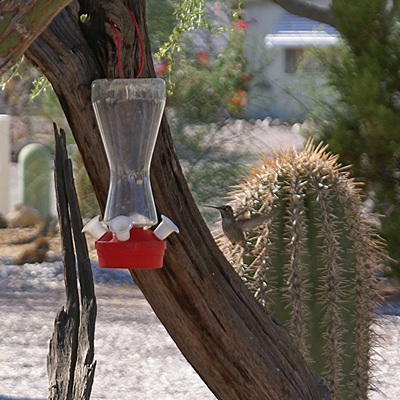
We have two humingbird feeders in the cactus garden by our coach. Look carefully to the right of the feeder.
When we got back to camp I had some of the leftover curry for lunch with some hot tea to help me warm up. Heavy clouds set in over the course of the afternoon and the air temperature was cool enough that I got slightly chilled. In spite of the chill, Linda went outside to continue working on her cross-stitch project. Butch set up their two-burner propane stove and made candy as he wanted to give some to Joe and Connie as a gift before they left on Saturday. With all that work going on around me I decided to take a nap.
Linda made a black beans and rice dish for dinner along with a green salad, both of which were very tasty. We bought a box of Franzia Sangria at Big Market the other day and finally tried it this evening. As with most of the Franzia wines it was not outstanding but also not offensive. Among inexpensive wines the Red Guitar Sangria is much fruitier and I like it better. While I would prefer a better wine, the Franzia boxed wines are around $13 for 5 liters, fit nicely in the refrigerator, can be consumed over a long time (at least eight weeks), and minimize garbage and recycling. All of those are positive attributes when living in the motorhome. We had fresh strawberries later for dessert, which are always a treat.
Our son (Brendan) sent a TXT message with a picture of our grand-daughter (Madeline) and the ornaments she had hung on their Christmas tree. She put five of them in a group at her eye level. She will be two years old in two more days and is fully aware that special things are happening and that she is a full participant in them, if not the center of attention. After dinner I resumed the task of cleaning up e-mails. I always promise myself that I will do better at managing my e-mails, but I never do.
